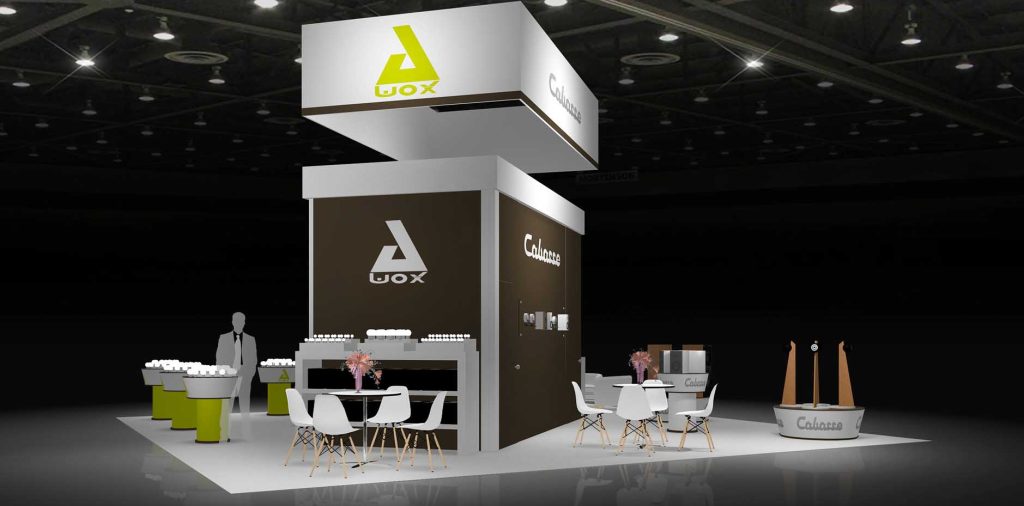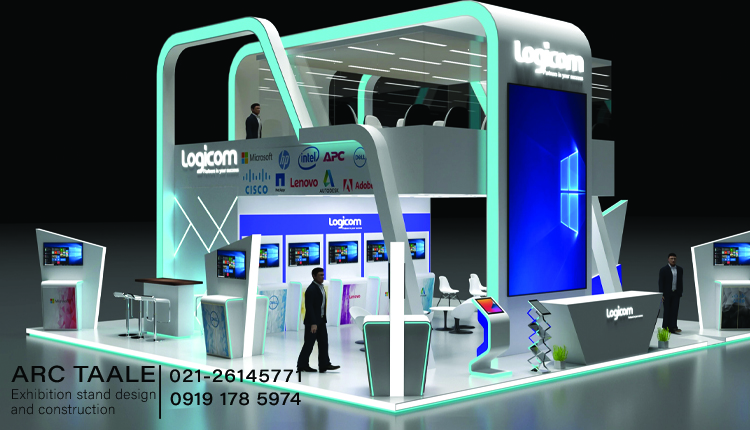An island exhibition stand, also known as an island booth or simply an island, is a type of exhibition display commonly used in trade shows, conferences, and other events. It refers to a freestanding exhibit that is open on all sides, usually surrounded by aisles or walkways. Unlike other types of exhibition stands, which are typically backed against a wall or positioned in a corner, an island stand is accessible from all directions.
Island Exhibition Stands Application and Usage
Island exhibition stands are a hallmark of innovation and creativity in the realm of trade shows and exhibitions. Situated in open areas with access from all sides, these stands create a captivating experience for both exhibitors and attendees. Here’s an in-depth exploration of their application and usage:
Strategic Placement and Visibility
Island exhibition stands are strategically positioned in central, high-traffic locations within exhibition halls. Their 360-degree accessibility ensures maximum visibility from all angles, making them ideal for businesses aiming to make a strong visual impact.
Brand Immersion
Island Exhibition Stands offer a canvas for immersive brand experiences. With ample space for large displays, interactive technology, and creative installations, exhibitors can transform the stand into a branded environment. From product showcases to multimedia presentations, island stands facilitate comprehensive brand immersion.
Versatile Design Possibilities
The spacious layout of Island Stands allows for versatile design possibilities. Exhibitors can create designated zones for product displays, demonstration areas, meeting spaces, and interactive exhibits. The design can incorporate architectural elements, multi-level structures, and eye-catching graphics, enhancing the booth’s visual appeal.
Enhanced Interactivity
Island booths encourage interactive engagement. Exhibitors can incorporate touchscreens, VR experiences, product demos, and live presentations, captivating attendees and encouraging active participation. Interactive elements create memorable experiences, leaving a lasting impression on visitors.
Networking and Hospitality
Island Exhibition Stands offer ample space for networking and hospitality. Designated meeting areas, lounges, and refreshment stations provide comfortable spaces for one-on-one discussions with potential clients, partners, or investors. These spaces enhance relationship-building opportunities and foster meaningful connections.
Branding Opportunities
Island booths provide extensive branding opportunities. Large banners, hanging signs, floor graphics, and illuminated displays ensure that the booth is visible from afar. Consistent branding elements reinforce brand identity, making it easier for attendees to identify and recall the exhibiting company.
Flexible Layouts
Island stands offer flexibility in layout and design. Walls and partitions can be added or removed to adapt the booth’s configuration based on specific event requirements. This adaptability ensures that the booth remains versatile, catering to different exhibition spaces and audience dynamics.
Island Exhibition Stand Construction Process
Constructing an island exhibition stand is a meticulous and strategic process that demands careful planning, creativity, and attention to detail. This multifaceted endeavor involves several key stages, each contributing to the stand’s overall impact and success. Here’s an insight into the construction process of island exhibition stands:
Conceptualization and Design
The process begins with conceptualization and design. Exhibitors collaborate with experienced designers to translate their vision into a tangible plan. Detailed blueprints, 3D renderings, and virtual walkthroughs are created, mapping out the stand’s layout, interactive elements, branding features, and overall aesthetics.
Permitting and Compliance
Obtaining necessary permits and ensuring compliance with local regulations and exhibition venue guidelines are crucial steps. This involves understanding building codes, safety regulations, and logistical requirements. Exhibitors work closely with organizers to secure permits and approvals, ensuring a seamless setup process.
Material Selection and Fabrication
Selecting high-quality materials is fundamental to the construction process. From structural elements to finishing touches, materials for island exhibition stand are chosen based on durability, aesthetics, and brand alignment. Skilled craftsmen fabricate components off-site, ensuring precision and quality control.
Transportation and Logistics
Coordinating transportation logistics is pivotal. Components are carefully packed, labeled, and transported to the exhibition venue. Timing and coordination are critical to ensure that all elements arrive on schedule, allowing for sufficient setup time before the event begins.
On-Site Setup and Assembly
The on-site setup phase involves skilled technicians and craftsmen assembling the stand. This phase demands meticulous attention to detail, with a focus on structural integrity, stability, and seamless integration of design elements. Collaboration between various teams ensures that the stand takes shape as envisioned.
Integration of Interactive Elements
interactive elements such as touchscreen displays, VR installations, and product demonstrations are integrated during the setup. Technicians ensure that all interactive features function smoothly, providing attendees with engaging and immersive experiences. Rigorous testing is conducted to prevent technical glitches during the event.
Branding and Graphics Installation
Branding elements, including banners, signage, and digital displays, are meticulously installed to align with the overall design. Graphics are carefully positioned to maximize visibility and brand exposure. Attention to alignment, color accuracy, and resolution ensures a professional presentation.
Final Inspection and Quality Assurance
A comprehensive final inspection is conducted to ensure that every element meets quality standards. Booth functionality, aesthetics, branding consistency, and interactive features are meticulously reviewed. Any issues are promptly addressed to guarantee a flawless presentation during the event.
Costs of Island Exhibition Stands
Creating an impactful island exhibition stand involves a strategic financial investment tailored to a company’s goals and vision. The cost of an island booths is influenced by a variety of factors, each playing a crucial role in determining the final budget. Here’s an in-depth exploration of the elements that contribute to the cost of island booths:
Design Complexity and Customization
The complexity of the stand’s design and the level of customization significantly impact costs. Elaborate architectural structures, unique layouts, and intricate detailing demand skilled craftsmanship, driving up the overall expenditure.
Size and Space Requirements
The size of the island exhibition stand directly correlates with costs. Larger stands require more materials, labor, and time for construction. Additionally, the space requirements influence the selection of interactive elements, branding materials, and furnishings, all of which contribute to the overall budget.
Suggested article: The Advantages of Exhibiting Abroad
Materials and Finishes
The choice of materials and finishes plays a vital role in cost determination. Premium materials, such as high-quality wood, glass, metal, or specialized finishes, incur higher expenses. The selection is influenced by both aesthetic preferences and budget constraints.
Interactive Technology and Features
Integrating interactive technology, such as touchscreens, augmented reality (AR), virtual reality (VR), and interactive displays, enhances attendee engagement but adds to the budget. The complexity and sophistication of these features impact island exhibition stand costs, as they require specialized equipment and programming.
Branding Elements and Graphics
Branding elements, including banners, signage, digital displays, and graphics, are essential components of an island stand. High-resolution graphics, vibrant colors, and large-scale branding materials contribute to the overall impact but also incur costs. Branding elements are tailored to match the stand’s design theme and brand identity.
Lighting Design
Lighting design enhances the stand’s ambiance and visibility. Strategically placed lighting fixtures, specialized lighting effects, and electrical requirements for interactive displays contribute to the budget. Energy-efficient LED lighting solutions are popular choices for their impact and sustainability.
Logistics and Installation
Transportation, on-site installation, labor, and dismantling services are integral parts of the budget. Logistics and installation costs depend on the stand’s size, complexity, and location of the exhibition venue. Timely coordination and efficient logistics management are crucial to avoiding additional expenses.
In summary, the cost of island exhibition stands is influenced by design complexity, size, materials, interactive technology, branding elements, lighting design, furniture, logistics, project management, and post-event evaluation. Each element is carefully tailored to align with the exhibitor’s objectives and brand identity. An investment in an island exhibition stand is an investment in creating a powerful and memorable brand presence, maximizing attendee engagement, and achieving exhibition goals effectively


